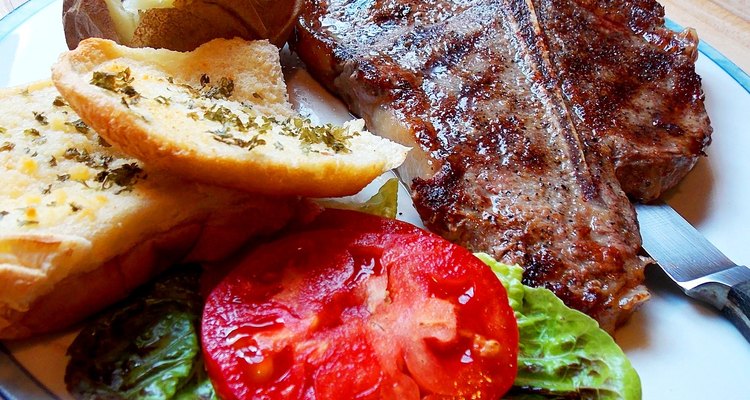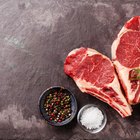
JJPaden/iStock/Getty Images
The porterhouse is a common favorite among American steak lovers. Though it looks similar to a t-bone steak, a porterhouse contains an extra muscle on the central-upper side. When trimmed of fat, the porterhouse is quite lean and the National Cattlemen’s Beef Association reports that 3 ounces of lean beef contain more than 50 percent of the recommended daily intake of protein. Rich in a host of essential nutrients, the porterhouse is healthy by itself. However, the Mayo Clinic lists broiling as one of the healthiest methods of preparation, enhancing the flavor, tenderness and the healthful nature of the porterhouse steak.
Purchase your meat from a reputable butcher rather than a commercial grocer where possible. Butchers handle the meat professionally, specializing in the proper handling of meat and animal products. Further, grass-fed beef, which is generally healthier than grain-fed beef, is most commonly found through butchers.
Season your steaks according to your taste. If you choose to marinade your steak, refrigerate it for at least one hour before use.
Find the location of your broiler in your oven. Most ovens will contain a broiler at the top of the oven. Some gas ovens will locate it in a drawer below the oven, in the place where pots, pans and other utensils are normally stored.
Preheat your broiler on a high heat after moving the oven rack to the second position from the top -- this allows the broiler more room to circulate the heat needed to cook the steak evenly.
Oil your steaks with olive oil instead of applying oil directly to the surface of the broiler pan, as this reduces the amount of excess smoke produced by the high heat.
Place your porterhouses on the broiler pan and broil until they are visibly brown around the entire visible surface. Flip the steaks and cook them according to desired doneness: A reading between 120 F and 125 F indicates a rare steak. A medium steak will register at 140 F to 150 F. Expect an internal temperature above 160 F for well-done steaks.
When the meat is cooked to your satisfaction, remove it and let it rest for 10 minutes to redistribute the juices before serving.
Serve the steaks warm with your desired sides or toppings.
Related Articles

How to Cook a Salmon Steak in the Oven

How to Grill a Ribeye on a Weber Q

How to Cook a Steak After Using a ...

How to Cook Deer Steaks in the Oven on ...

How to Cook London Broil
How to Cook Boneless Top Chuck Steak in ...

How to Cook Steak on a Baking Sheet

How to Broil Filet Mignon Wrapped in ...

The Best Way to Cook Sirloin Steak ...

How to Cook a Frozen Pork Fillet in the ...

Choice Vs. Prime Beef Grades

How Hot Should a Grill Be for Steaks?

How to Cook Deer Sirloin

How to Pan Cook a Sirloin to Medium-Well

How to Cook Marinated Pork Loin From a ...

How to Cook Ultra Thin Sirloin

How to Cook Angus Beef Steak

How to Cook Cowboy Cut Ribeye

How to Get Skirt Steak Tender
How to Cook a Spencer Roast
References
Photo Credits
JJPaden/iStock/Getty Images